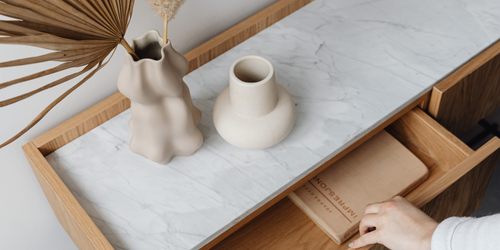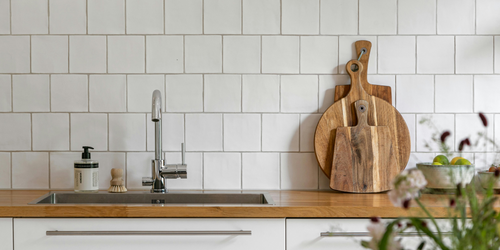The time has finally come to replace your furniture.
The couch’s cushions have turned into a sinkhole that your guests have to pull themselves out of, the “shabby chic” coffee table you got in college is falling apart, and you’ve reached the point in your adult life where you deserve more than a foldout, plastic table to dine at.
Okay, maybe it’s not that dire. Maybe you just want new furniture for the new year. A fresh start.
But of course… You’re conscious about sticking to your “green values'' when you’re shopping for new furniture. You want something nice, but not necessarily mass-produced. You’d love a soft, cozy couch to curl up on… But have no idea where to look for eco-friendly materials.
While consumerism and eco-friendly don’t always go hand in hand when looking at big chain furniture stores, here are some tips for picking out conscientious (and comfy!) furniture.

Origin Stories Matter
Perhaps before you even begin to look at what sort of fabrics and materials your prospective furniture is made out of… You need to look at where it came from.
It is no secret that the majority of US-sold products are imported, and furniture is no exception. Furniture and its parts are US’ #11 import, with their primary makers being China, Vietnam, and Malaysia.
While the world and its development depends on imports and exports, the particular outsourcing of goods and services from other countries to the USA hits a few ethical nerves. The most publicly discussed of these issues concerns US companies paying cheaper prices for labor because third world countries’ minimum wage is so much lower. Often these countries don’t have labor unions to protect their workers, and the work can be both exhausting and dangerous.
But even if we were to conveniently forget the United States’ greed for cheap labor, we have to remember there are unethical practices in the attaining of materials as well.
We touched on it in our palm oil article, but deforestation for timber has played a critical role in severely limiting rain forest habitats in places like the Amazon and Indonesia. Don’t get us wrong: deforestation in the US is still very much an issue, and we definitely need to hold ourselves accountable for the destruction of our lands.
But many of the countries we get our cheap imports from are lax with their deforestation laws, and the resources are sometimes even obtained illegally. Malaysia in particular lost as much as 17% of its forests in a span of 18 years.
On top of deforestation to create them, there’s also the matter of getting the furniture and its parts to the US. International aviation and shipping accounts for 3.5% of greenhouse emissions, and while this seems a small number it is still something to consider when buying a local coffee table vs, say, one made a whole ocean away.
If you’re shopping furniture online, just be sure to check where it was made. Better yet: try to find a local maker! Not only will you be supporting a community business, you’ll save that money on shipping too.
Materials to Consider
A couch may look super soft… But looks can be deceiving.
Let’s talk about the toxic chemicals that companies hide between their cushions.
Spill resistant fabric, for example, sounds like a dream: a sofa that no sippy cup of milk or glass of wine can soak through and stain? Who wouldn’t want that?
Unfortunately, not all that glitters is gold. Spill resistant furniture often contains fluorinated chemicals. While the longterm effects aren’t quite yet clear, a scientific panel in a lawsuit against DuPont (the creators of nonstick Teflon, which itself is a fluorinated chemical) were able to conclude that there was a probable link between these chemicals and certain diseases.
Some types of furniture made with composite wood - like particle board or plywood - have shown to have high levels of formaldehyde.
And then there’s the innocent sounding vegan leather.
While we’re rooting for all alternatives to animal product-materials, vegan leather is all too often made with polyvinyl chloride--a plastic that isn’t biodegradable.
Plywood, vegan leather, spill-proof fabric - that’s a whole lot of scary dont's on top of a preference to avoid wood.
Thankfully, that still leaves us plenty of materials to work with!
An angel-sent alternative to wood in recent years has been the wonderful bamboo, which is not only cost effective but very sustainable. It’s quick to regrow, with its fastest species able to grow up to 35 inches in a single day.
In terms of fabric, we always forget about the classic organic cotton and hemp. Both plant-based fabrics are made without pesticides or insecticides, so you can rest assured that there aren’t any harmful chemicals lingering upon harvest.
Interested in pieces that use recycled materials as opposed to whole new resources? Good, because in recent years it’s absolutely becoming a trend. Companies like Avocado and Burrow are renowned for using upcycled materials for their furniture.
Hopefully we’re seeing this trend being set a little more in stone, as even big names like West Elm are catching on with their own eco-friendly collections.
Thrifting, Thrifting, Thrifting
We can’t lie. It’s our favorite.
Thrifting is one of the best things you can do for the environment--especially if you’re wanting to buy some new furniture.
Remember how in our blog/love letter to thrifting we talked about how a good 10% of carbon emissions come from the fashion industry? Scary statistics can also be said about the furniture industry as a whole. According to the EPA, 80.2% of the furniture produced in 2017 ended up in the landfill. The problem is this model of “fast furniture” similar to fast fashion: products from companies are cheaper, but they don’t last as long.
Enter a good thrift shop in your neighborhood.
The point of a good thrift shop is to sell back items in good and usable condition - not something that’ll quickly fall apart soon. Sure, there might be microscopic wear and tear (we call those love marks!) - but overall, it’s still a perfectly good piece that would otherwise be put in the dump.
Better yet: it’s way cheaper than if you were to buy brand new furniture.
The exciting part about thrifting furniture also has to do with how creative you can get. Not sure that the color of this sofa will work for your living room? Look into a masterclass to teach you how to reupholster. Like the shape of a dresser, but not the style? Here’s some inspiration on changing it!
There’s so much you can do with thrift furniture with so much less money - especially if it’s got some good “bones” to it.
While buying brand new furniture is really exciting, we just want to remind you that there are so many more options that are both sustainable and stylish.
It might be intimidating to realize that all your old furniture wasn’t exactly eco-friendly - but everyone is on their own learning curve, and knowing what you know now makes it so much more exciting to buy new furniture.
Make your home a green one, and we promise: it’ll be so much cozier that way.















